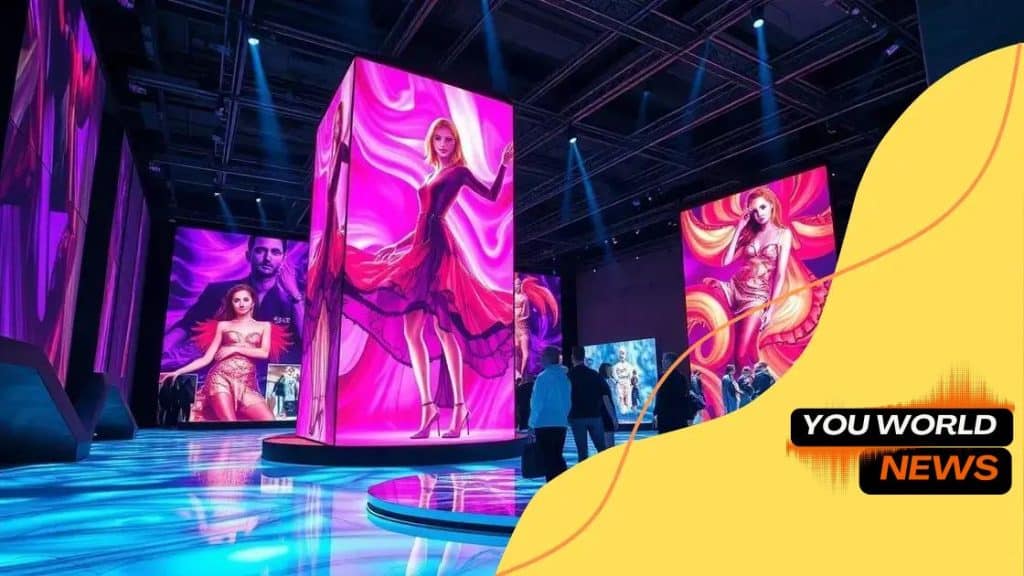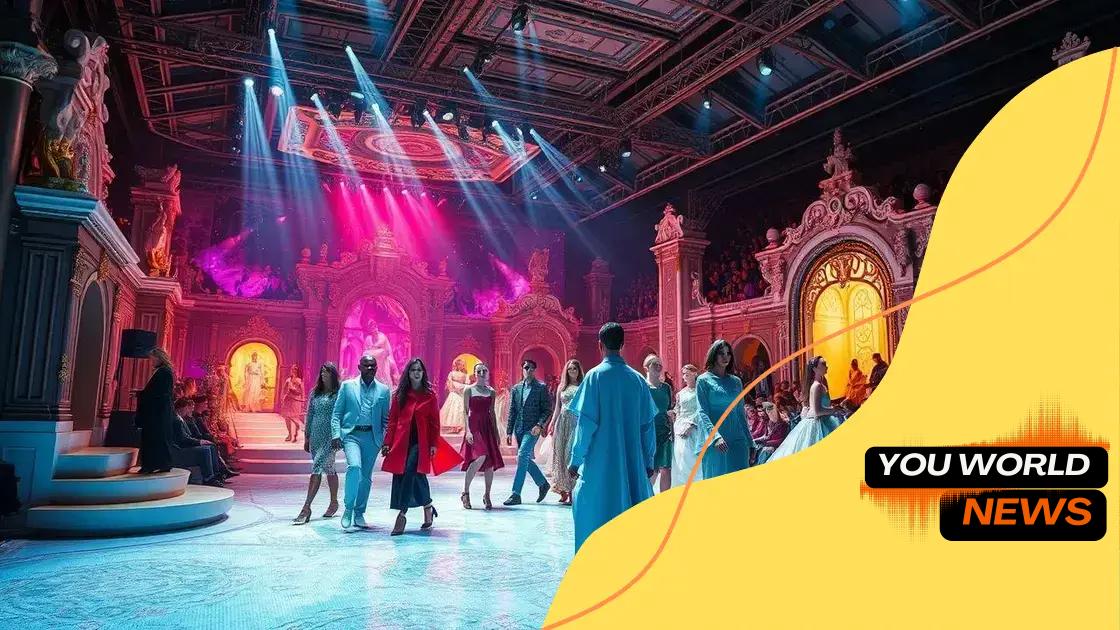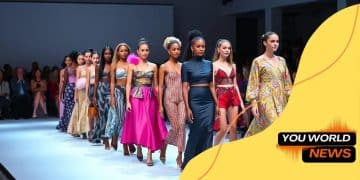The rise of immersive fashion exhibitions

The rise of immersive fashion exhibitions merges technology, sustainability, and storytelling to create engaging, participatory experiences that redefine how audiences interact with fashion.
The rise of immersive fashion exhibitions is changing the game in the fashion world. Imagine walking into a space where creativity meets technology, allowing you to experience fashion like never before. Intrigued? Let’s explore this fascinating trend.
Understanding immersive fashion exhibitions
Immersive fashion exhibitions are a thrilling new way to experience style and creativity. They allow visitors to step inside a world where fashion comes alive through technology and artistry. In this section, we’ll take a closer look at what makes these exhibitions unique and engaging.
The essence of immersive fashion
At the heart of immersive fashion exhibitions is the desire to create a multisensory experience. Unlike traditional fashion shows, which typically take place on a runway, immersive exhibitions invite guests to interact with the environment. This interaction enhances the connection between the audience and the artistic vision behind the outfits.
Elements that define immersive experiences
Several key elements contribute to the success of an immersive fashion exhibition:
- Innovative technology: Tools like augmented reality and virtual reality bring the designs to life.
- Multi-sensory aspects: Sound, light, and scent play crucial roles in creating an unforgettable atmosphere.
- Engaging narratives: Stories are woven throughout the exhibition, enhancing the emotional connection to the pieces.
These elements not only entertain but also educate the audience about the fashion industry, making the experience enriching.
As you walk through an immersive fashion exhibition, you’ll notice how the layout and design help guide your journey. The spatial arrangement encourages exploration, and every corner offers something new to discover. For instance, you may find interactive displays that invite you to engage with the materials used in the garments. This interactivity allows visitors to delve deeper into the artistry behind each outfit.
Additionally, the focus on storytelling invites the audience to form connections with the designs. Rather than merely observing, attendees become participants in a broader narrative about fashion, culture, and identity. This shift fosters a more profound appreciation of the craft, inspiring conversations and reflections long after the exhibition ends.
In sum, understanding immersive fashion exhibitions means recognizing their potential to transform the way we experience fashion. They are spaces where creativity flourishes and where everyone can explore the intersections of art and life.
Key techniques used in immersive fashion
In immersive fashion, unique techniques breathe life into static designs. These methods captivate the audience and enhance their experience. Understanding the key techniques used in immersive fashion can reveal how artists transform the traditional presentation into a dynamic journey.
Augmented reality experiences
Augmented reality (AR) plays a vital role in creating engaging experiences. By overlaying digital elements onto the real world, AR makes fashion interactive. Visitors can see designs in action, try on outfits virtually, and experience collections from different angles.
- Virtual try-ons: Guests use AR to see how clothes fit without actually wearing them.
- Interactive displays: Screens that respond to movements make fashion accessible and fun.
- Enhanced storytelling: AR layers narratives over the garments, allowing audiences to connect deeply.
This combination of reality and digital elements makes every exhibition unique and thrilling.
Spatial design and layout
The way spaces are designed is crucial for an immersive experience. Curators use layouts that encourage exploration and interaction. Each space tells a story, guiding visitors through a carefully crafted journey.
Flow and movement are essential for engagement. Strategically placed exhibits let attendees move at their own pace, discovering new designs. This creates an organic experience that feels less like a presentation and more like an adventure.
Lighting also plays a key role in setting the mood. Bright lights can create excitement, while softer lights can evoke emotions. This attention to detail enhances the overall immersion.
Sensory engagement
Beyond just visuals, immersive fashion engages multiple senses. Scents and sounds enhance the atmosphere. For instance, the scent of a garden might accompany a floral collection. Sounds of nature or music complement the visual displays, making the experience vibrant.
- Soundscapes: Music or ambient sounds add depth to the exhibition.
- Scents: Specific fragrances can be associated with different collections.
- Textural experiences: Visitors are encouraged to touch materials, deepening their interaction.
This sensory mixing heightens emotional connections with the designs.
Through innovative techniques like AR, thoughtful spatial design, and sensory engagement, immersive fashion breathes new life into traditional practices. Together, these elements create unforgettable experiences that resonate long after leaving the exhibition.
Famous examples of immersive fashion shows

Throughout the years, several immersive fashion shows have captured the public’s imagination. These events redefine how fashion is presented, blending art, technology, and storytelling. By exploring some of the most famous examples, we can see how they pushed the boundaries of creativity and audience engagement.
Balenciaga’s exhibit at the Museum of Modern Art
In 2017, Balenciaga showcased an exhibit at the Museum of Modern Art in New York. This immersive experience invited attendees to step into a space where they could touch and interact with the designs. The use of mirrors and innovative display techniques created a sense of infinite space, enhancing the connection between the audience and the fashion.
Gucci’s fall 2020 show
Gucci’s fall 2020 show took place in a vivid and surreal setting. The show featured a stage full of elaborate sets, creating a dreamlike atmosphere. Models walked through rooms filled with stunning visuals and props that told a coherent story. This approach drew in the audience, making them feel part of an unfolding narrative rather than just passive observers.
- Unique styling: Each model’s outfit was intricately styled to fit the surreal theme.
- Immersive storytelling: The sets complemented the themes of the clothing, creating a cohesive experience.
- Audience interaction: Guests felt as if they were stepping into a living artwork.
By transforming the runway into a narrative landscape, Gucci elevated the experience to new heights.
Prada’s spring/summer 2021 show
Prada’s spring/summer 2021 show presented a unique blend of fashion and passionate performance. The venue was designed to resemble an old theater, where the models performed rather than just walked. This approach allowed for a narrative thread that engaged the audience, showcasing how clothes can tell stories and convey emotions.
This type of presentation adds depth to fashion. Instead of merely observing, attendees become immersed in a performance that merges artistry with wearable design. Such innovative shows challenge traditional perspectives on runway presentations.
Overall, famous examples of immersive fashion shows highlight how creativity can transform the viewer’s experience. As fashion continues to evolve, these groundbreaking events inspire new ways to engage audiences and redefine the fashion narrative.
The impact on audience engagement
The impact of immersive fashion exhibitions on audience engagement is profound. These events draw people in and transform how they interact with fashion. Instead of merely watching a presentation, attendees become active participants, which enhances their overall experience.
Creating memorable experiences
Immersive fashion allows guests to create lasting memories. Every aspect, from the design to the layout, is crafted to evoke emotions and inspire connections. When people can touch, see, and feel the fashion, their engagement deepens.
- Interactive elements: Hands-on displays give guests the chance to explore textures and materials.
- Personalized experiences: Many exhibitions allow visitors to customize their experience based on their preferences.
- Social sharing: As guests engage, they are more likely to share their experiences on social media.
This sharing amplifies the reach of the exhibition, drawing in even more interested audiences in the future.
Building a community
Immersive exhibitions foster a sense of community among attendees. People often bond over their shared experiences and explore fashion together. This camaraderie enhances engagement, as individuals feel part of something bigger than themselves.
Moreover, fashion brands can create forums within these exhibitions for discussions about trends and sustainability. This dialogue encourages participants to think critically about their fashion choices and promotes a community spirit.
Overall, the impact of immersive fashion exhibitions on audience engagement is significant. By creating memorable experiences and fostering community, these events transform how we interact with fashion. They not only change perceptions but also inspire a deeper connection to the art of fashion.
Future trends in fashion exhibitions
The future of fashion exhibitions is an exciting landscape filled with innovation and creativity. As technology continues to evolve, designers and curators are exploring new ways to engage audiences. Looking ahead, several trends are likely to shape the direction of immersive fashion.
Increased use of technology
One significant trend is the integration of advanced technologies like virtual reality (VR) and augmented reality (AR). These tools allow visitors to experience fashion in entirely new ways. Imagine walking through a virtual environment that allows you to view garments from every angle, or even trying on clothes digitally.
- VR experiences: Visitors can step into a digitally created fashion world.
- AR try-ons: Users can see how clothing looks on them without wearing it physically.
- Interactive displays: Technology enabling real-time engagement with the exhibit.
This technological shift makes exhibitions more engaging and personalized.
Sustainability as a focus
Another important trend is the emphasis on sustainability within fashion. More brands are recognizing the impact of their practices on the environment. Future exhibitions are likely to highlight eco-friendly materials and ethical production methods.
By showcasing sustainable practices, exhibitions can educate the audience about responsible fashion choices. This shift not only enhances brand image but also fosters a community of conscientious consumers.
Emphasis on storytelling
Storytelling will play an even more prominent role in future exhibitions. Designers will weave narratives into their presentations, making every piece part of a larger story. This approach invites visitors to connect emotionally with the fashion.
Exhibitions can incorporate multimedia elements like video, audio, and interactive displays that support the storytelling experience. This dynamic engagement captivates the audience and drives home the message behind each collection.
In conclusion, the future of fashion exhibitions looks bright, with technology, sustainability, and storytelling as key pillars. These trends promise to create more engaging, informative, and responsible ways to experience fashion, inviting audiences to participate actively in the narrative of style.
\n
FAQ – Frequently Asked Questions about Immersive Fashion Exhibitions
What are immersive fashion exhibitions?
Immersive fashion exhibitions combine technology, art, and storytelling to create engaging experiences where visitors actively participate in the presentation of fashion.
How does technology enhance these exhibitions?
Technology, like augmented reality and virtual reality, allows visitors to experience fashion in new ways, such as trying on clothes virtually or interacting with displays.
Why is sustainability important in fashion exhibitions?
Sustainability highlights the importance of eco-friendly materials and ethical practices, educating audiences about responsible fashion choices and promoting a positive impact on the environment.
How do these exhibitions foster audience engagement?
By creating interactive elements and memorable experiences, immersive exhibitions encourage active participation, allowing guests to connect emotionally with the designs and the stories behind them.





